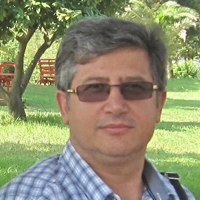Validating MODIS cloud mask using a regional cloud mask based on AVHRR data
Introduction Cloud has an important role in the study of radiation balance and greenhouse gases due to water vapor existing in the greenhouse gases of atmosphere. Clouds can reflect sun radiate in the top of atmosphere based on their thickness and density. Iran country has different regions in regards to cloudiness. For example the north of Iran has a cloudy sky over most days of year, while cloudy conditions is low in the central regions of Iran. One of the most important datasets in order to cloud detection is satellite data. The two main of sensors that can be used in meteorology are Moderate Resolution Imaging Spectroradiometer (MODIS) sensor aboard Terra and Aqua Platforms and Advanced Very High Resolution Radiometer (AVHRR) aboard National Oceanic and Atmospheric Administration (NOAA) that were used in this paper. By far, various cloud detection algorithms are applied to different satellite observations over various land surfaces globally. AVHRR level1 data is used to introduce a regional cloud detection scheme for two regions in Iran which have different geographical characteristics. Most cloud mask algorithms were developed globally using different spectral tests and have not examined and validated at regional scale. For example MODIS cloud mask (MCM) algorithm applies five group tests in visible, near infrared, and thermal spectral regions. The goal of the study is to validate the MCM based on AVHRR data and radiative transfer model simulation of clear sky brightness temperature (BT). Data and methods Gilan is located in southern coastal of Caspian Sea with maritime climate whereas Khohgiluyeh Va Boyerahmad have a mountainous climate. Five spectral threshold tests were used for the regions and also Radiative Transfer for Television and Infrared Observation Satellite (TIROS) Operational (RTTOV) simulation of clear sky BT was applied for clear sky BT thresholding. Snow have detected by NearIR(1.6) /VIS(0.6) test ranging values below and equal than 0.2 with a BT test at 12 μm ranging -8.16 to 11.84 degrees Celsuis. Third test was reflectance test. Fourth test was a NearIR (0.9)/VIS (0.6) which have ranging 0.6 to 1.3 over cloudy area, finally a clear sky BT test was applied to the areas. Results and discussion These all tests were applied to five dates with highest positive anomalies (Dec 2003, Oct 2006, Jan 2008 and Nov2011) and highest negative anomaly (Dec 2010) during 2001-2015. The results showed that although an extended area have values below and equal than 0.2, BT test for cloudy region have values below than -8.16 degrees Celsuis. With examining the fourth test, the test indicated that the values between 0.6 and 1.3 over Gilan and 0.7 and 1.3 over Khohgiluyeh Va Boyerahmad can detect clouds. The fifth test revealed interesting results due to it showed different properties over low and high skin temperature area so that an area with values of skin temperature higher than 5 degrees Celsuis experienced clear sky BT colder than cloudy sky temperature and vice versa. This test showed that the values of T12μm below than -2.5 degrees Celsuis can detect clouds in both cases (skin temperature below than 5 degrees Celsuis and greater than 5 degrees Celsuis) over Khohgiluyeh Va Boyerahmad whereas values of 5 and -13.68 degrees Celsuis can be used for the thresholding over the area with skin temperature greater and below than 5 degrees Celsuis over Gilan province, respectively. The results showed that these tests can well detect clouds over more than 90 percent of points. With applying these tests over 90 and 91 points of Gilan and Khohgiluyeh Va Boyerahmad, the results showed good agreement between new cloud mask and MCM and weather stations total cloud cover data. Conclusions The objective of the study was to valdate MCM using AVHRR data and weather stations data. Results regards to applying the radiative transfer model revealed a very interesting effect on cloud detection. It is a first attempt to introduce a regional cloud mask over Iran, it is suggested the use of SEVIRI data with higher temporal resolution over two regions and also other radiative transfer simulation results can compare to the radiative transfer model applied in this research. Also it is recommended to use more points and dates for such researches for acquiring accurate results. Key words: cloud detection, AVHRR, RTTOV, Gilan, Khohgiluyeh Va Boyerahmad
-
Evaluation of PERSIANN family satellite precipitation data on daily, monthly and annual scale in Iran
Ramyar Yusef Nejad, Manouchehr Faraj Zadeh *, Yousef Gavidel Rahimi
Journal of Remote Sensing and GIS Applications in Environmental Sciences, -
Investigation of UV erythema radiation and total ozone for the city of Tehran during the period of 2013-2023
Zahra Shariepour *, Abbasali Aliakbari Bidokhti
Iranian Journal of Geophysics, -
Laboratory study of surface effects on acoustic signal fluctuations
Zeinab Masjedi, Sara Allahyaribeik *, Mohammad Akbarinasab, Abbasali Aliakbari Bidokhti, Amirhooman Hemmasi
Hydrophysics Journal, -
Paleoclimatology of Fellaw Lake Area_ Iraq: A review
Nazar Jameel Khalid, Manuchehr Farajzadeh *, Yousef Ghavidel Rahimi, Majid Shah Hosseini
Journal of Sustainable Earth Trends, Jul 2024


